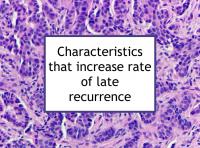Although hormone receptor positive breast cancer that does not overexpress HER2 (in other words, ER+/PR+/HER2- receptor status) has a deserved reputation for not being as aggressive as triple negative (ER-/PR-/HER2-) or inflammatory (IBC) breast cancer, this advantage does not continue to confer a survival benefit over the long term.
While ER+/PR+/HER2- breast cancer is less likely to relapse during the first five to seven years after diagnosis, it represents an increasing proportion of relapses after this point. Now a new study has reported that breast cancer recurrence 10 to 32 years after diagnosis is more likely among women with large ER+ tumors and positive lymph node status.
Characteristics of low-risk breast cancer
Generally speaking, breast cancer with all of the following characteristics has a very low risk of recurrence (under 2%) during the first five years after diagnosis:
- ER+/PR+/HER2- receptor type and luminal A molecular phenotype
- Tumor was found by screening mammography, could not be felt by hand
- Small tumor size (under 2 cm)
- Lymph node negative
- Single tumor (not multicentric, multifocal or diffuse)
- Clear surgical margins
- Treated with radiotherapy after breast-conserving surgery.
However, there is some evidence that women who are vitamin D deficient or obese at diagnosis are at higher risk of relapse even if they have tumors with the favorable characteristics listed above.
Factors linked to late recurrence or ER+ breast cancer
Late recurrence is breast cancer relapse that takes place at least five to seven years after the initial diagnosis of breast cancer. Late recurrence is thought to be caused by dormant (non-proliferating) breast cancer cells that found their way to the bone marrow or other secondary sites at some point. These tumor cells evaded eradication during treatment because they were not dividing at the time. The process of eventual reactivation from tumor dormancy is poorly understood.
Estrogen exposure does not appear to drive the process by which ER+ cancer cells move to sites where they can remain viable but dormant. However, estrogen does fuel the growth of such cells and can help convert clusters of them (micrometastases) into tumors. Extended treatment with tamoxifen (for 10 years rather than five) has been shown to prevent late recurrence in higher-risk ER+ breast cancer patients.
Tumor-specific characteristics that have been linked to late ER+ recurrence include large tumor size, positive lymph status, relatively low ER positivity and certain genetic factors, as well as the presence of circulating tumor cells. Other factors that have been shown to be associated with late recurrence include obesity, alcohol intake, and cigarette smoking.
Latest research identifies characteristics linked to late recurrence
The study referenced above was designed to investigate breast cancer recurrence occurring 10 to 32 years after diagnosis, as well as the associated patient and primary tumor characteristics. To conduct the study, the authors first identified all 36,924 women diagnosed with early-stage breast cancer between 1987 and 2004 in the Danish Breast Cancer Group clinical database. The authors then restricted the study population to the 20,315 10-year disease-free survivors (i.e., those who lived 10 years after diagnosis without a recurrence or new cancer). The women were followed until year-end 2018.
A total of 2,595 10-year disease-free survivors relapsed during the study period. Recurrences occurred up to 32 years after initial breast cancer diagnosis. The cumulative rate of recurrence in the study population was 8.5% 15 years after diagnosis,12.5% at 20 years, 15.2% at 25 years, and 16.6% at 32 years. Tumor size greater than 2 cm, positive lymph node status, and ER+ disease each were found to be associated with increased risk of late recurrence. The authors conclude that patients with the identified characteristics may warrant extended surveillance, more aggressive therapies, or new treatment approaches.
Please see our article on ER+/PR+ breast cancer prognosis and the late recurrence tag for more information.
